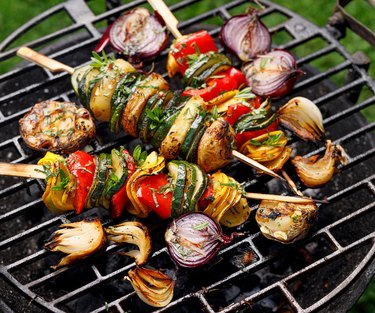
Though both charboilers and grills use grates as a cooking surface and leave grill marks on food, they have a few subtle differences. Charbroilers are almost exclusively for commercial use, while grills may be designed for home or commercial use. In most cases, charbroilers don't have lids, while most quality grills do. It's easy to confuse charbroilers and grills, especially since the Char-Broil company makes gas grills rather than charbroilers.
Charbroiler Essential Traits
Video of the Day
The typical charbroiler offers a large, open cooking area with a much larger cooking surface or grate than the average grill, allowing for mass quantities of food to be cooked at once. They're often large and heavy enough that they're meant to stay in one place, which is usually within a commercial kitchen. These beefy restaurant charbroilers are often gas-powered using either propane or a natural gas hookup. Gas models have a heating element that warms the grill grates more evenly than a charcoal grill in particular. Radiant-heat models use an angled piece of metal above the flame source to heat the grates, while other harder-to-clean models heat lava rocks beneath the grates instead.
Video of the Day
Even though they're mainly used indoors, charbroilers require ventilation. They also have a built-in means of collecting grease and food drippings; this is often a tray or pan that pulls out for easier cleaning. Some charbroilers have back and side splashes to contain messes, which also helps ensure that grease and spatter from adjacent cooking gear in use don't get into the charbroiler.
There are exceptions to these usual charbroiler traits. Countertop models are compact enough to fit atop any flat working surface. Some charbroilers, such as those used by catering companies or private clubs, can be used outdoors, and they may be plug-in electric models instead of gas.
Grill Essential Traits
In many cases, a grill is smaller than a charbroiler, although small charbroilers do exist. Grills may be open on top or have lids; quality grills usually come with a lid. In commercial scenarios, chefs use the grill lid to regulate temperature and to enhance the smoky flavor of foods, such as ribs or steak. A traditional grill uses charcoal as a heat source beneath the grill grate, although propane-powered grills are also quite popular.
While charbroilers are almost always square or rectangular and generally look like a boxy device with legs, a grill usually looks a bit different, especially the residential varieties. Grills may also be disc-shaped, egg-shaped, domed, or a bit like a barrel on its side and cut in half to maximize the grilling area.
Charcoal grills take far longer to heat up than gas grills and charbroilers. It's also a bit more difficult to gauge cook time or levels of heat in various parts of a warm charcoal grill since the coals may be warmer in one area than another. Residential grills should be used outdoors, with the exception of small countertop electric grills, such as any number of products in the George Foreman line. Many of these also double as panini or sandwich presses.